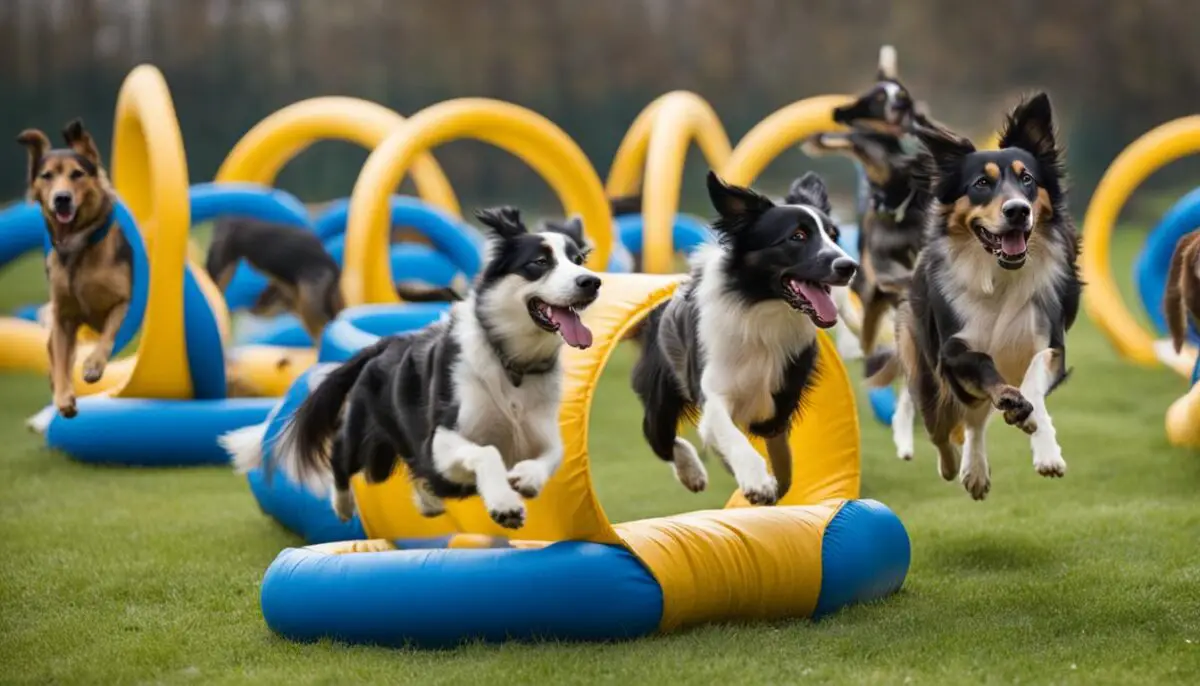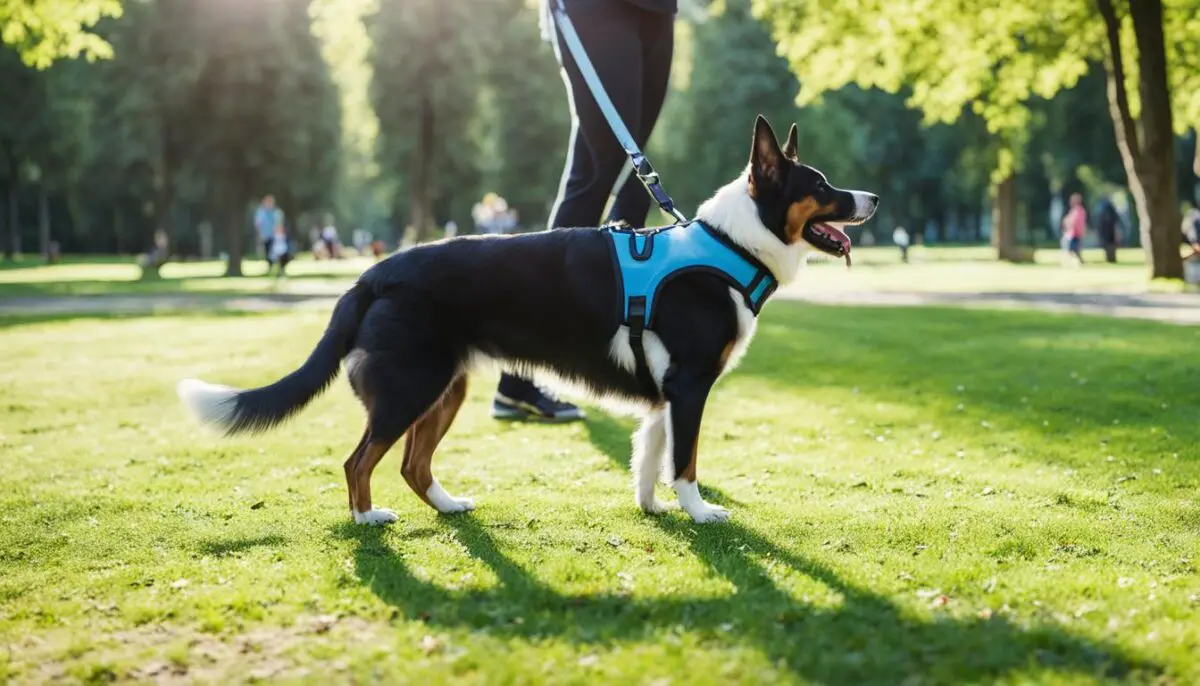Regular exercise is crucial for ensuring the overall well-being of your dog. It helps prevent unwanted behaviors and chronic conditions while promoting a healthy weight. But how do you know how much exercise your dog needs? That’s where a dog exercise needs calculator comes in. By inputting factors such as breed, age, size, and temperament, you can determine the ideal amount of daily exercise for your furry friend. This personalized exercise plan will keep your dog healthy and happy.
Key Takeaways:
- Regular exercise is important for your dog’s well-being and can prevent unwanted behaviors and chronic conditions.
- A dog exercise needs calculator can help you determine the ideal amount of daily exercise based on factors such as breed, age, size, and temperament.
- Tailoring your dog’s exercise routine to their specific needs will ensure they stay healthy and happy.
- Always prioritize your dog’s safety and consult with a veterinarian before starting any new exercise routine.
- By providing the right amount and type of exercise, you can help your dog maintain a healthy weight and prevent health issues.
Determining Your Dog’s Exercise Needs
Various factors come into play when determining your dog’s exercise needs. The breed, age, size, and temperament of your dog all influence the amount and type of exercise they require. Different breeds have different energy levels and activity requirements. Puppies have different exercise needs compared to adult dogs, and senior dogs may need a more gentle approach. It’s important to consider these factors when creating an exercise routine for your dog.
Tailoring Exercise for Your Dog
Once you have determined your dog’s exercise needs, it’s important to tailor the activities to their specific requirements. Different dogs have different energy levels and interests, so providing a variety of exercises ensures they stay engaged and motivated. Here are some options for different activity levels:
Light Activity for Dogs
For dogs that require light activity, gentle exercises like leisurely walking, swimming, and mental stimulation activities can be beneficial. Taking your dog on a relaxing walk or teaching them new tricks using interactive toys can keep them physically and mentally stimulated without overexertion.
Moderate Activity for Dogs
For dogs with moderate activity needs, options like brisk walks, backyard training games, and games of fetch or tug of war can provide the right amount of exercise. These activities help burn energy and engage their minds, keeping them entertained and physically fit.
Intense Activity for Dogs
For dogs with high energy levels and intense exercise requirements, activities like fast-paced games of fetch, running off-lead, or agility training can be great options. These activities provide a high level of physical exertion and mental stimulation, challenging your dog and keeping them fit.
Remember, it’s important to choose activities that are appropriate for your dog’s physical abilities and interests. Pay attention to their energy levels during and after exercise to ensure they are not overexerted or exhausted.

Provide a well-rounded exercise routine that includes a mix of light, moderate, and intense activities to meet your dog’s specific needs. This variety ensures they receive the right amount of exercise to stay healthy and happy. Remember to always monitor your dog’s behavior and consult with a veterinarian if you have any concerns about their exercise routine.
Tips for Exercising Your Dog Safely
When it comes to exercising your dog, safety should always be your top priority. By taking a few simple precautions, you can ensure that your furry friend stays healthy and happy during their workout sessions. Here are some essential tips for exercising your dog safely:
- Provide plenty of water: Hydration is crucial for dogs, especially during exercise. Always make sure to have a sufficient amount of water available for your dog to drink throughout their workout. This will help prevent dehydration and overheating.
- Monitor your dog’s behavior: Pay close attention to your dog’s behavior and watch for signs of exhaustion. If you notice heavy panting, excessive drooling, or your dog sitting or lying down frequently, it’s time to take a break. These are indications that your dog may be tired and needs rest.
- Start slow and gradually increase intensity: If your dog hasn’t been exercising regularly, it’s important to start with low-intensity activities and gradually build up their endurance. This approach allows their muscles and joints to adjust and reduces the risk of injury.
- Consult with a vet: Before starting any new exercise routine, it’s always a good idea to consult with your veterinarian. They can provide personalized advice based on your dog’s breed, age, and overall health. Your vet can also address any specific concerns you may have and guide you in creating an exercise plan that suits your dog’s needs.
By following these tips, you can ensure that your dog exercises safely and enjoys a healthy and active lifestyle. Remember, the key is to be attentive to your dog’s needs and listen to their cues. Regular exercise, along with proper care and attention, will contribute to your dog’s overall well-being.
| Tip | Description |
|---|---|
| Provide plenty of water | Hydration is crucial for dogs, especially during exercise. Always make sure to have a sufficient amount of water available for your dog to drink throughout their workout. |
| Monitor your dog’s behavior | Pay close attention to your dog’s behavior and watch for signs of exhaustion. If you notice heavy panting, excessive drooling, or your dog sitting or lying down frequently, it’s time to take a break. |
| Start slow and gradually increase intensity | If your dog hasn’t been exercising regularly, it’s important to start with low-intensity activities and gradually build up their endurance. |
| Consult with a vet | Before starting any new exercise routine, it’s always a good idea to consult with your veterinarian. They can provide personalized advice based on your dog’s breed, age, and overall health. |

Exercise Needs for Puppies
Puppies have different exercise needs compared to adult dogs due to their growing bodies. It’s crucial to provide them with appropriate exercise that promotes their health and development. Determining the right amount and type of exercise for puppies can be a bit challenging, but with some guidelines, you can ensure their well-being.
As a general rule, puppies benefit from about five minutes of exercise per month of age, up to twice a day. For example, a 4-month-old puppy would benefit from 20 minutes of exercise twice a day. It’s important to keep in mind that these are just guidelines, and each puppy is unique.
When determining exercise for puppies, it’s essential to prioritize their safety and avoid strenuous or high-impact activities. Puppies’ bodies are still developing, and intense exercises can potentially harm their growing bones and joints. Instead, focus on gentle activities that allow for socialization and exploration.
Consider your puppy’s breed and energy level when determining their exercise routine. Some breeds have higher energy levels and may require more exercise, while others may be more laid-back.
Gentle activities suitable for puppies include:
- Short walks around the neighborhood or in a safe park
- Playtime with age-appropriate toys
- Interactive games that stimulate their minds
- Supervised playdates with other friendly dogs
Always keep an eye on your puppy during exercise sessions, and watch for signs of fatigue or exhaustion.

Remember, puppies have bursts of energy but also need plenty of rest and sleep. Avoid over-exercising them, as it can cause fatigue and potentially lead to behavior problems. As your puppy grows, their exercise needs will change, so it’s important to adapt their routine accordingly.
Providing appropriate exercise for puppies not only keeps them physically healthy but also helps with their socialization and mental stimulation. By ensuring a balance between exercise and rest, you can set a solid foundation for a happy and healthy adult dog.
Exercise Needs for Adult Dogs
The exercise needs of adult dogs vary based on their breed, size, and energy level. Understanding the appropriate amount and type of exercise for your adult dog is essential to keeping them healthy, both physically and mentally.
For active breeds like Border Collies or Labrador Retrievers, exercise requirements are higher. These dogs may need over 2 hours of daily activity to satisfy their energy levels. This includes a combination of physical exercise and mental stimulation to keep them engaged and prevent boredom.
On the other hand, low-energy breeds like Bulldogs or Basset Hounds have lower exercise needs. These dogs are generally content with 30 minutes to an hour of exercise each day. However, it’s important to ensure that this exercise is appropriate for their specific needs and doesn’t strain their physical limitations.
When it comes to exercise guidelines for adult dogs, it’s crucial to choose activities that suit their individual needs and energy levels. Regular activities such as walks, fetch, or dog sports can be great options. Mixing up the activities can help prevent boredom and keep your dog motivated.
Remember that every dog is unique, and their exercise needs may vary even within the same breed. Observing your dog’s behavior and energy levels can provide valuable insights into whether their exercise routine is appropriate or needs adjustments.
Benefits of Regular Exercise for Adult Dogs:
- Helps maintain a healthy weight
- Improves cardiovascular health
- Builds muscle strength
- Enhances mental stimulation and reduces behavioral issues
- Promotes socialization and bonding with their human companions
Regular exercise is not only crucial for your adult dog’s physical well-being but also for their mental and emotional health. It provides an outlet for their energy, prevents obesity, and keeps them mentally stimulated. A well-exercised dog is a happy and balanced dog.
Sample Exercise Routine for Adult Dogs:
| Activity | Duration | Frequency |
|---|---|---|
| Morning Walk | 30 minutes | Once daily |
| Fetching in the Park | 20 minutes | Once daily |
| Puzzle Toys | 15 minutes | Once daily |
| Training Session | 10 minutes | Once daily |
| Evening Walk | 30 minutes | Once daily |
Exercise Needs for Senior Dogs
As dogs age, their exercise needs may change. While they may become less active, it’s still important to provide them with regular, low-impact activities to maintain joint flexibility and overall well-being. Senior dogs may need shorter and gentler exercise sessions compared to their younger counterparts. Walking and swimming are ideal low-impact exercises for senior dogs.
Walking allows senior dogs to engage in physical activity while being gentle on their joints. It provides mental stimulation, an opportunity to explore their surroundings, and the chance to socialize with other dogs and humans. Swimming, on the other hand, is a great low-impact exercise that is easy on their joints and helps improve muscle strength and cardiovascular health.
It’s crucial to monitor the behavior of senior dogs during exercise and adjust the routine accordingly. If they show signs of fatigue, discomfort, or struggle to keep up, it’s recommended to shorten the duration or intensity of their exercise sessions. Regular vet check-ups can also provide guidance on the appropriate exercise regimen for aging dogs, taking into account any specific health conditions or limitations they may have.
Remember, the goal of exercise for senior dogs is to promote their well-being, maintain a healthy weight, and keep them mentally stimulated. With the right exercise routine, senior dogs can lead happy, active, and fulfilling lives.
| Exercise Guidelines for Senior Dogs | Benefits |
|---|---|
| Walking | Promotes joint flexibility, mental stimulation, and socialization |
| Swimming | Low-impact exercise that improves muscle strength and cardiovascular health |
Conclusion
Tailoring an exercise routine to meet your dog’s specific needs is essential for their overall well-being. Regular exercise helps prevent unwanted behaviors, maintains a healthy weight, and prevents chronic conditions. By considering factors such as breed, age, size, and energy level, you can determine the ideal amount and type of exercise for your dog.
Always prioritize their safety and consult with a veterinarian for personalized guidance. They can provide valuable insights and recommendations based on your dog’s individual needs. A tailored exercise plan will not only keep your dog physically fit but also promote mental stimulation and improve their quality of life.
Remember, exercise should be a fun and enjoyable experience for both you and your furry companion. Engage in activities that your dog loves, whether it’s playing fetch, going for a walk, or exploring new trails together. By providing tailored exercise, you can ensure that your dog remains healthy, happy, and thriving for years to come.
FAQ
How do I determine how much exercise my dog needs?
You can use a dog exercise needs calculator to determine the ideal amount of daily exercise for your dog. Factors such as breed, age, size, and temperament are taken into account to create a personalized exercise plan.
What factors should I consider when determining my dog’s exercise needs?
The breed, age, size, and temperament of your dog all influence the amount and type of exercise they require. Different breeds have different energy levels and activity requirements, while puppies and senior dogs may have specific needs.
What types of activities should I include in my dog’s exercise routine?
It’s important to tailor the activities to your dog’s specific requirements. Light activities such as leisurely walking and swimming are great for dogs, while moderate activities can involve brisk walks or intense games of fetch. Intense activities could include running off lead or agility training for lively dogs.
How can I ensure that I’m exercising my dog safely?
It’s essential to provide plenty of water for your dog during exercise and to pay attention to their behavior and signs of exhaustion. Panting, sitting, and laying down are indications that your dog may be tired and needs a break. Always start slow if your dog hasn’t been exercising regularly and consult with your vet before starting any exercise routine.
How much exercise do puppies need?
Puppies have different exercise needs compared to adult dogs due to their growing bodies. A general guideline is to provide five minutes of exercise per month of age, up to twice a day. Gentle activities that allow for socialization and exploration are important for puppies.
How much exercise do adult dogs need?
The exercise needs of adult dogs vary depending on their breed, size, and energy level. Active breeds may require over 2 hours of activity per day, while low-energy breeds may be content with 30 minutes to an hour of exercise daily. Regular activities such as walks, fetch, or dog sports can be great for adult dogs.
How much exercise do senior dogs need?
As dogs age, their exercise needs may change. While they may become less active, it’s still important to provide them with regular, low-impact activities to maintain joint flexibility and overall well-being. Walking and swimming are ideal low-impact exercises for senior dogs.
Why is tailoring an exercise routine important for my dog’s well-being?
Tailoring an exercise routine to meet your dog’s specific needs is crucial for their overall well-being. Regular exercise helps prevent unwanted behaviors, maintains a healthy weight, and prevents chronic conditions. By considering factors such as breed, age, size, and energy level, you can determine the ideal amount and type of exercise for your dog.
